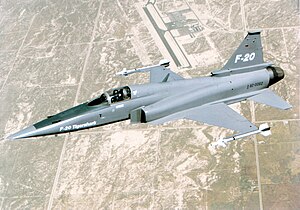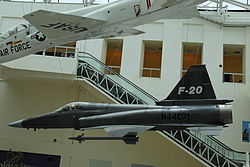An interesting "could have been" twist to the F-5 saga;
...
The
Northrop F-20 Tigershark (initially
F-5G) was a
light fighter, designed and built by
Northrop. Its development began in 1975 as a further evolution of Northrop's
F-5E Tiger II, featuring a new engine that greatly improved overall performance, and a modern avionics suite including a powerful and flexible
radar. Compared with the F-5E, the F-20 was much faster, gained
beyond-visual-range air-to-air capability, and had a full suite of air-to-ground modes capable of firing most U.S. weapons. With these improved capabilities, the F-20 became competitive with contemporary fighter designs such as the
General Dynamics F-16 Fighting Falcon, but was much less expensive to purchase and operate.
Much of the F-20's development was carried out under a
US Department of Defense (DoD) project called "FX". FX sought to develop fighters that would be capable in combat with the latest
Soviet aircraft, but excluding sensitive front-line technologies used by the
United States Air Force's own aircraft. FX was a product of the
Carter administration's military export policies, which aimed to provide foreign nations with high quality equipment without the risk of US front-line technology falling into Soviet hands. Northrop had high hopes for the F-20 in the international market, but policy changes following
Ronald Reagan's election meant the F-20 had to compete for sales against aircraft like the
F-16, the USAF's latest fighter design. The development program was abandoned in 1986 after three prototypes had been built and a fourth partially completed.
[1]
...
...

en.wikipedia.org





